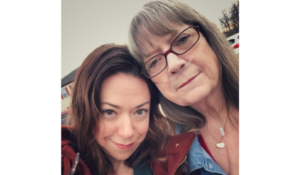by: Gari Lister
 One of my youngest daughter’s biggest challenges is self esteem – and sadly her lack of self esteem is combined with an inability to imagine and dream. Not dream at night, but dream of an exciting future. My sweet girl can very easily imagine herself getting cancer, or epilepsy, or even cystic fibrosis (yes, she “knows” she can’t come down with some diseases, but that doesn’t stop her from worrying about them). On the other hand, she finds it nearly impossible to believe she can set goals and reach them, let alone imagine the kinds of things most children think of — the olympics (she’s an ice skater and swimmer), or even the job of her dreams. She knows about her early trauma, and she tends to think her differences make success in a traditional sense impossible, especially since she sees her big sister, another victim of early childhood trauma who dropped out of high school, struggle to make ends meet.
One of my youngest daughter’s biggest challenges is self esteem – and sadly her lack of self esteem is combined with an inability to imagine and dream. Not dream at night, but dream of an exciting future. My sweet girl can very easily imagine herself getting cancer, or epilepsy, or even cystic fibrosis (yes, she “knows” she can’t come down with some diseases, but that doesn’t stop her from worrying about them). On the other hand, she finds it nearly impossible to believe she can set goals and reach them, let alone imagine the kinds of things most children think of — the olympics (she’s an ice skater and swimmer), or even the job of her dreams. She knows about her early trauma, and she tends to think her differences make success in a traditional sense impossible, especially since she sees her big sister, another victim of early childhood trauma who dropped out of high school, struggle to make ends meet.
I encourage her, of course, but telling someone to dream isn’t exactly an effective approach.
So last summer I started searching for what I will call “success story” books — true stories about people who have built a life that most anyone would admire despite their traumatic starts. I found a number of books, and I’m going to write a series of posts about them just in case someone else’s child – or someone else – needs some real life stories of success after early trauma.
The first book I found was a great one — Michaela de Prince’s Taking Flight, published in 2014. Michaela is a professional award-winning ballerina dancing with the Dutch National Ballet; she previously danced with the Dance Theatre of Harlem and studied at the American Ballet Theatre. And she’s only 20! Before she was adopted from war-torn Sierra Leone by an American family when she was 4, Michaela lost both her parents and was brought to an orphanage by her uncle. She also has vitiligo (a condition that leads her skin to have what appears to be white spots and discoloration), and was targeted in Sierra Leone as a “devil” child because of her skin. She also saw a favorite teacher viciously murdered. Amongst all that trauma, she found a scrap of paper – a magazine cover – with a ballerina on it, and says that picture inspired her to become a dancer.
Only the first 68 pages address her years before her adoption, but they include a disturbing description of the favorite teacher’s murder, so some pre-teens and teens may not be able to handle them. But even if your child cannot handle reading the entire book, I think there are still benefits to the story. I showed my daughter the book, and talked about Michaela as I read it. She didn’t ask to read the book, but I did tell her some of the stories from it, and as I pulled out the book to write this, she pored over the photographs and asked me questions about it.
Michaela doesn’t directly discuss the impact of her trauma; she certainly doesn’t talk about attachment or even PTSD. But there are passages that describe her struggles to adjust . She describes she and her sister being afraid of fireworks and camouflage, and explains that reflections in windows brought back fears of “debils,” who killed people in Sierra Leone. She confesses that “even today I don’t like bare windows at night. I still feel the need to close my blinds tightly after dark.” (P. 112)
Michaela also describes a fear that all three of my girls have — a fear of “loud male voices,” whether the volume is because of anger or laughter. “If I heard men shouting, I remembered the frightening voices of the debils on a rampage in my native Sierra Leone.” (P.113) That fear continued even when she was finding success as a ballet dancer – she describes hiding from Arthur Mitchell, the founder of the Dance Theatre of Harlem the summer she studied there. (P. 160)
Overcoming the shadow of her early years, dealing with her feelings about her vitiligo, and discrimination are themes throughout the book, and they are certainly themes that our children struggling to overcome trauma need to hear about. And the movie rights have been sold to the book, with a director already signed up, so hopefully we will get to see her story on the big screen soon.
And Michaela de Prince certainly summed up the challenge so many of our children face. She told Glamour: “You don’t have to hold on to your past, . . . If you can find a way to overcome the bad parts, great things can happen.” Hopefully her book and her story will help us parents – and our children – remember that.


